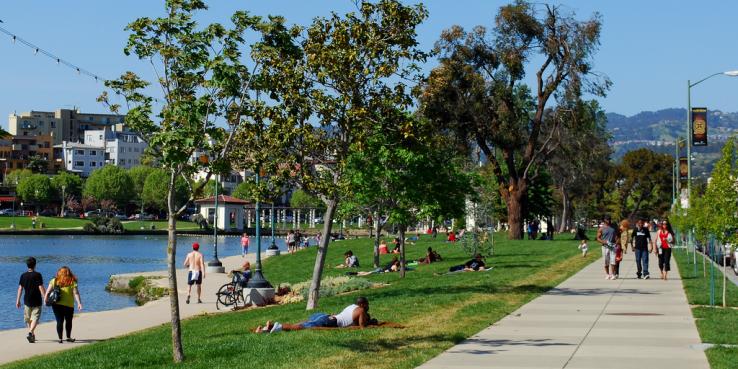Certain kinds of public space allow us to look at the city from the city. Large openings in the tight fabric of streets and buildings — think of San Francisco’s Embarcadero, New York City Central Park’s Sheep Meadow, the banks and bridges of Paris’s Seine — allow enough distance and respite to take the city in, but are close enough to feel embedded in its energy. Oakland’s Lake Merritt is one of our grandest and most beloved examples of great public space, unique in the region and deeply embedded in its community. And after a decade of thoughtful reinvestment, it is thriving.
Lake Merritt provides Oakland residents and visitors with an outdoor sanctuary in the midst of one of the Bay Area’s densest urban environments. It ties together Downtown and a diverse series of central Oakland neighborhoods, offering a fragment of nature, a prospect on the city and its topography, and common ground that is palpably and eclectically democratic — a rarity in the Bay Area’s fragmented social landscape.
Historically, Lake Merritt was part of the San Francisco Bay. Formed at the mouth of several creeks, this tidal lagoon had a wide outlet connecting it to the greater bay estuary. First called the San Antonio Slough, after the 1820 Rancho San Antonio land grant, Lake Merritt was once ringed by marshes and wetlands. In 1868, Oakland mayor Samuel Merritt proposed that a dam be built, separating the slough and the bay, which remain connected by a tidal channel. Merritt’s vision was to create a place for recreation, and the resulting lake took his name. Merritt also proposed the lake be protected as a wildlife refuge, and in 1870 the California State Legislature established the Lake Merritt Wildlife Refuge as the first of its kind in North America.
Despite good intentions, Lake Merritt struggled with public access and water quality issues throughout the 20th century. This began to change in the 1980s, as wastewater reroutes and dredging improved water quality. The current revitalization effort began in 2001, when a group of concerned citizens formed the Coalition of Advocates for Lake Merritt (CALM). Brainstorming a list of improvement projects, CALM partnered with the City of Oakland to put forth Measure DD. In 2002 this city bond passed, setting aside $198 million to restore and improve Lake Merritt.
Working with limited resources, the City of Oakland has made improvements around the lake, along the channel and on the nearby Oakland waterfront with the goals of enhancing public access, preserving historic landmarks and boosting ecosystems. Most improvements have focused on hydrology and environmental cleanup, while a few tackled major gaps in the walking paths like the 12th Street shoreline. One of the most notable changes has been the 12thStreet Reconstruction project. Completed in the summer of 2013, it demolished the “mini-freeway” on the lake’s southern shore and decreased automobile traffic from 12 lanes down to six. It also replaced unsafe pedestrian tunnels with graceful new bridges and paths.
From an environmental perspective, the most important aspect of this project was the removal of the Lake Merritt Channel dam. Replacing this dam with a clear-spanning bridge increased the lake’s tidal flow by 50 percent. More circulation between the bay and the lake has improved water quality and created new habitat opportunities for birds and fish. Measure DD also enhanced water quality by providing funding to install storm drain inlet screens and stormwater outlet filters throughout the Lake Merritt watershed.
Though the majority of projects funded by Measure DD have been completed, several are still in the pipeline. Similar to the 12th Street Reconstruction project, the Lake Merritt Channel Improvements project will replace existing culverts beneath 10th Street with a bridge spanning an open channel. Currently underway, this project is part of an effort to create better access between Lake Merritt and the Oakland waterfront. Measure DD also provides funding for closing gaps in the Bay Trail system. The Estuary Bay Trail Connections project funded by the measure will close a 6.6-mile gap in the Bay Trail between Jack London Square and 66th Avenue.
Revitalizing Lake Merritt with funds from Measure DD has had a ripple effect in the surrounding neighborhoods. Inspired by opportunities in the revitalized lake district, several nearby institutions — the Oakland Museum of California, the Henry J. Kaiser Auditorium, Laney College, Oakland’s main library and the Alameda County Courthouse — exploring better connections to the lake, each other and downtown Oakland. Better bike and pedestrian access via 12th Street has paved the way for better connectivity through these Oakland districts, rich in civic assets.
Together these improvements have been appropriately light-handed, building on the community’s simple impulse: to walk around the lake in one another’s company.
